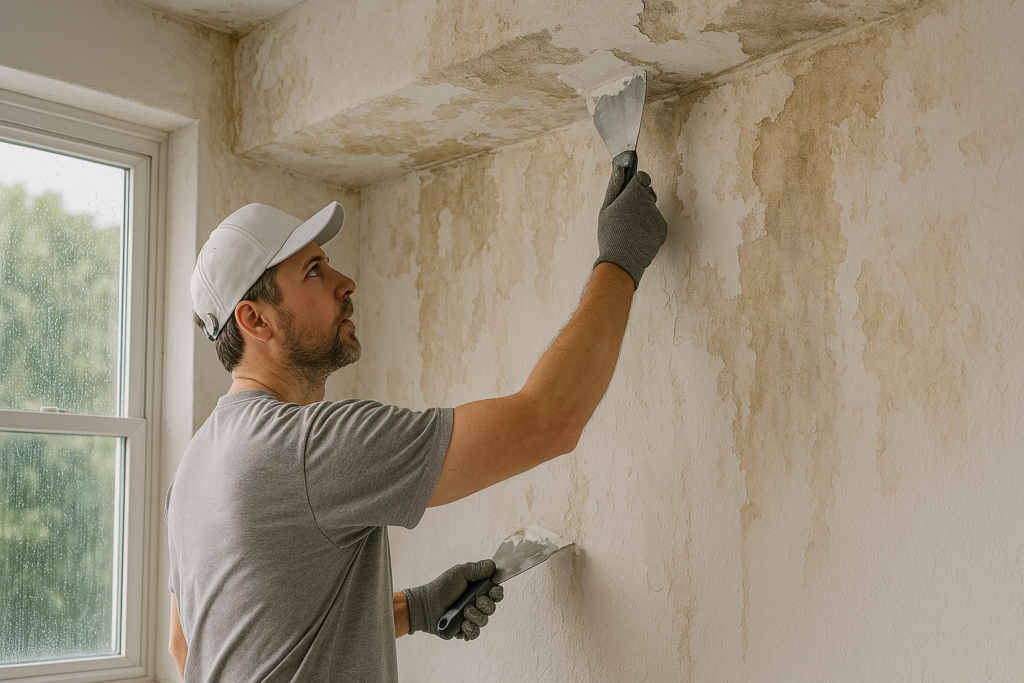Water damage can create a breeding ground for mold in your home, posing risks to both your property and health. Mold can begin to grow within 24-48 hours of water exposure, so early intervention is crucial. Recognizing the signs of mold and knowing how to address them swiftly can help keep your home safe. In this article, we’ll discuss how to identify mold after water damage and the necessary steps to take to prevent it from spreading.
Signs of Mold Growth Following Water Damage
1. Mold Growth
Mold growth is usually the most visible sign of a problem. Mold can manifest in different colors, including black, green, white, and orange. It often appears in moist areas like bathrooms, kitchens, or basements. Mold might look fuzzy, slimy, or even powdery. If you spot any of these growths on walls, ceilings, or floors, it’s vital to address them immediately. The quicker you act, the better you’ll be able to control its spread.
2. Persistent Musty Smell
A musty odor is another telltale sign of mold. Even if you can’t see any visible mold, the smell can indicate hidden mold growth. This smell is caused by mold spores being released into the air, and it will worsen over time if not dealt with. It’s essential to trace the source of the odor and eliminate any mold growth before the situation becomes severe.
3. Peeling or Bubbling Paint and Wallpaper
Water exposure can cause paint or wallpaper to peel, bubble, or distort. If you notice these changes, it could be due to moisture trapped behind the surface, potentially allowing mold to thrive. When water enters walls or ceilings, it disrupts the adhesion of the paint or wallpaper, leading to these issues. In these cases, it’s vital to not only remove the mold but also address the root cause of the water damage.
4. Water Stains on Walls or Ceilings
Water stains appear as discolored patches on surfaces like walls or ceilings. These stains may look yellow, brown, or rust-colored and typically form after water has seeped into the building materials. These areas often become perfect spots for mold to grow. Identifying and fixing the underlying water problem is essential to preventing mold from taking root in these spots.
5. Excessive Humidity or Condensation
High humidity levels are a breeding ground for mold. Condensation on windows, pipes, or walls is a sign that your indoor air moisture levels are too high. Humidity over 60% can encourage mold growth, so it’s essential to monitor your home’s humidity and take measures to control it. Use a dehumidifier or air conditioners to reduce moisture, and ventilate your home to prevent future mold problems.
6. Unexplained Allergies
Increased exposure to mold spores can trigger allergic reactions. Symptoms like coughing, sneezing, itchy eyes, and respiratory issues may indicate a mold problem. If you or anyone in your household is experiencing these symptoms after water damage or in areas with excessive moisture, it’s important to have the area checked for mold growth.
How to Effectively Deal with Mold After Water Damage
1. Identify and Fix the Water Source
Before addressing the mold itself, it’s essential to identify and fix the source of water damage. Whether it’s a leaking roof, broken pipes, or an appliance malfunction, stopping the flow of water is the first priority. Without resolving the underlying water issue, mold will continue to grow and spread. Once you’ve repaired the water issue, allow the affected area to dry completely before moving forward with mold remediation.
2. Clean Small Mold Areas
For minor mold infestations (less than 10 square feet), you can usually clean the area yourself. Use a mixture of water and dish soap or a store-bought mold cleaner to scrub the affected surfaces. Always wear protective gear such as gloves, a mask, and goggles to avoid inhaling mold spores during the cleaning process. Make sure the area is thoroughly dried afterward to prevent mold from returning.
3. Dispose of Mold-Infested Materials
In cases where mold has infested porous materials like drywall, carpet, or insulation, these materials should be removed and discarded. Mold can penetrate deeply into these materials, making it nearly impossible to clean them effectively. Always place moldy materials in sealed plastic bags to prevent further contamination when removing them from the home.
4. Improve Home Ventilation
Improving ventilation in your home can help prevent mold from regrowing. Make sure to open windows regularly, especially in areas like kitchens and bathrooms where moisture tends to accumulate. Use exhaust fans to increase airflow and reduce humidity. Installing a dehumidifier is also a great way to control indoor humidity, especially in areas like basements or attics.
5. Repair and Replace Damaged Materials
Once the mold has been cleared and the area is dry, you can begin repairing any damage. This may involve replacing drywall, repainting, or re-insulating affected areas. It’s important to use mold-resistant materials during the repair process, such as mold-resistant drywall, paints, and sealants. This will help reduce the likelihood of mold growth in the future.
6. Keep an Eye Out for Recurring Issues
Even after cleaning up mold, it’s essential to monitor the affected area for any signs of mold returning. Regularly inspect the space for moisture buildup or new mold growth. By staying vigilant, you can address any issues early before they become more severe.
Water damage provides an ideal environment for mold to thrive, making it important to detect and address mold growth promptly. Recognizing the signs, including visible mold, musty odors, peeling paint, and water stains, will help you take action before the situation worsens. After fixing the water issue and cleaning up the mold, it’s essential to take steps to prevent mold from returning. Regular maintenance, proper ventilation, and humidity control are key to maintaining a mold-free home.

